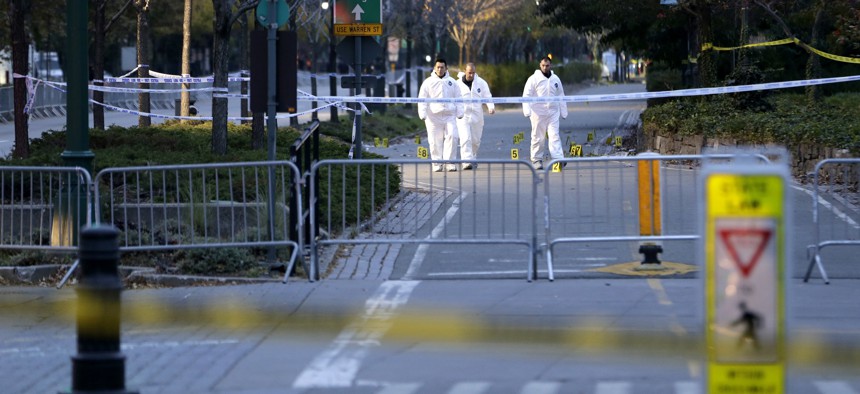The N.Y.C. Terror Attack Is Part of a Trend That’s Getting More Difficult to Combat

Emergency officials walk near evidence markers on the west side bike path in lower Manhattan, New York, Wednesday, Nov. 1, 2017. Seth Wenig / AP Photo
As attacks become less sophisticated, they are also becoming harder to prevent.
The vehicle-ramming attack in New York yesterday afternoon (Oct. 31) is the latest in a long line of less sophisticated “acts of terror.”
The incident, while described as the deadliest terror attack in New York since 9/11, was not an elaborate plot—it was conducted by a man who drove a pickup truck down a busy bike path in downtown New York, killing eight people. The 29-year-old suspect, named as Sayfullo Saipov who has been taken into custody, was initially described by law enforcement officials as a “lone wolf”—someone who was inspired by the Islamic State (ISIL) and acted alone (not someone who was directly instructed by the terrorist group). However, hours later there are reports saying he was “associated with ISIL.“
But what we do know is how this bears a resemblance to the most recent string of terror attacks, such as the one in London in June. These attacks are stark reminder of a disturbing trend: As terror attacks become less sophisticated, they are also becoming more difficult to prevent. Quartz considered the implications of this after the previous London and Stockholm attacks; the text is reproduced below.
Vehicle ramming attacks are devastatingly simple. Attackers don’t need bombs or much training—just a vehicle, basic driving skills, and the will to plow into a crowd. These kinds of attacks have escalated since the 2016 Nice attack, when a man drove a truck through a large crowd in the southern French city, killing more than 80 people.
The Islamic State (ISIL) took responsibility for the attack, and has since promoted the concept of vehicle attacks. In the November 2016 issue of the group’s Rumiyah magazine (pdf), ISIL said: “Though being an essential part of modern life, very few actually comprehend the deadly and destructive capability of the motor vehicle and its capacity of reaping large numbers of casualties if used in a premeditated manner.” The article contained an image of a rental truck and the Macy’s Thanksgiving Day Parade in New York.
Vehicle attacks have risen accordingly. There have been nearly as many vehicle ramming incidents in the past three years (including those targeting the public, police, and military) as there were in the preceding decade, according to Stanford’s Center for International Security and Cooperation.
Vehicle ramming attacks are devastatingly simple. Attackers don’t need bombs or much training—just a vehicle, basic driving skills, and the will to plow into a crowd. These kinds of attacks have escalated since the 2016 Nice attack, when a man drove a truck through a large crowd in the southern French city, killing more than 80 people.
The Islamic State (ISIL) took responsibility for the attack, and has since promoted the concept of vehicle attacks. In the November 2016 issue of the group’s Rumiyah magazine (pdf), ISIL said: “Though being an essential part of modern life, very few actually comprehend the deadly and destructive capability of the motor vehicle and its capacity of reaping large numbers of casualties if used in a premeditated manner.” The article contained an image of a rental truck and the Macy’s Thanksgiving Day Parade in New York.
Vehicle attacks have risen accordingly. There have been nearly as many vehicle ramming incidents in the past three years (including those targeting the public, police, and military) as there were in the preceding decade, according to Stanford’s Center for International Security and Cooperation.
Aamna Mohdin is a London-based reporter for Quartz, where this article was originally published.
NEXT STORY: Most States Given Lousy Pretrial Justice Grades





